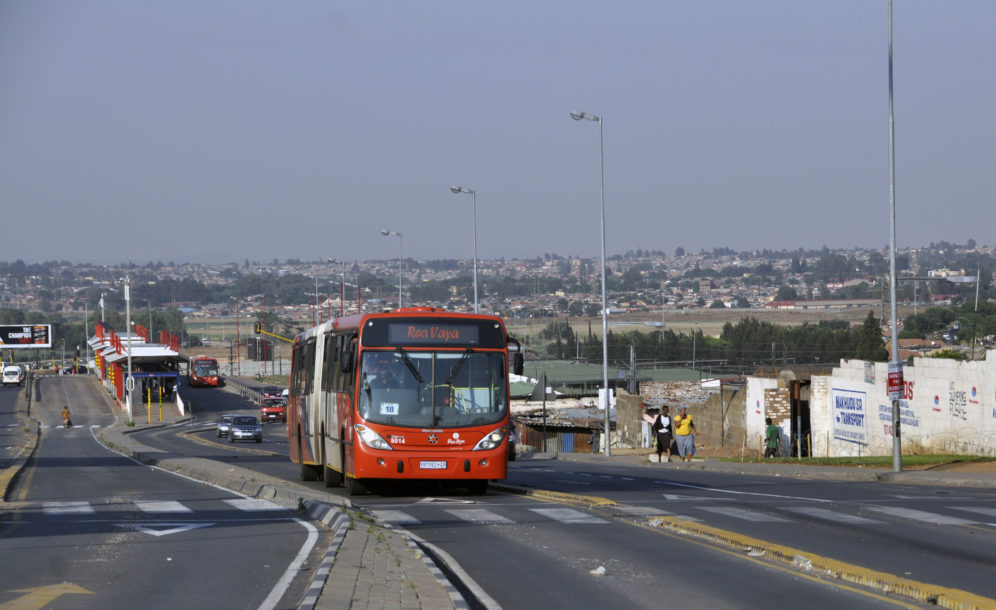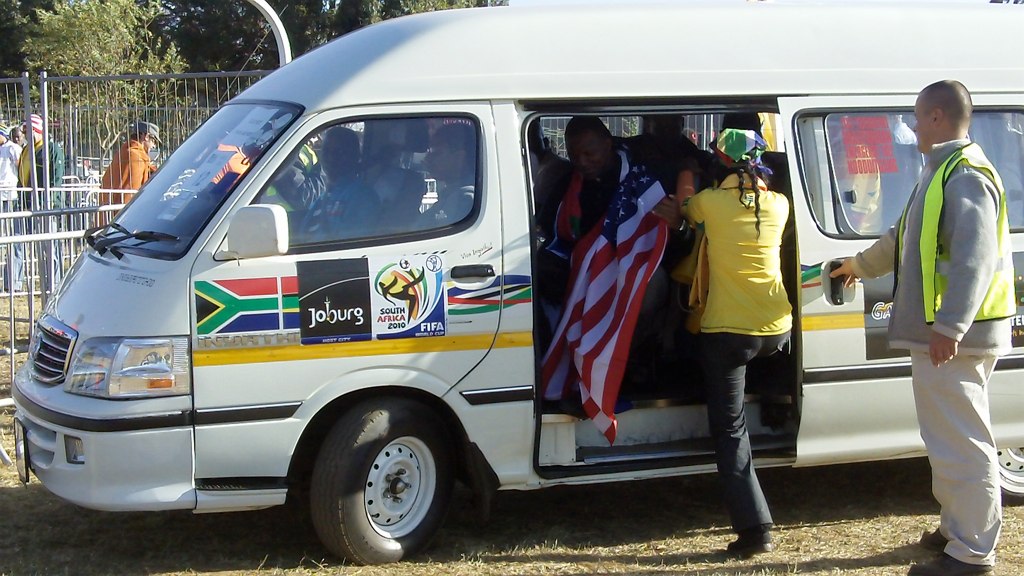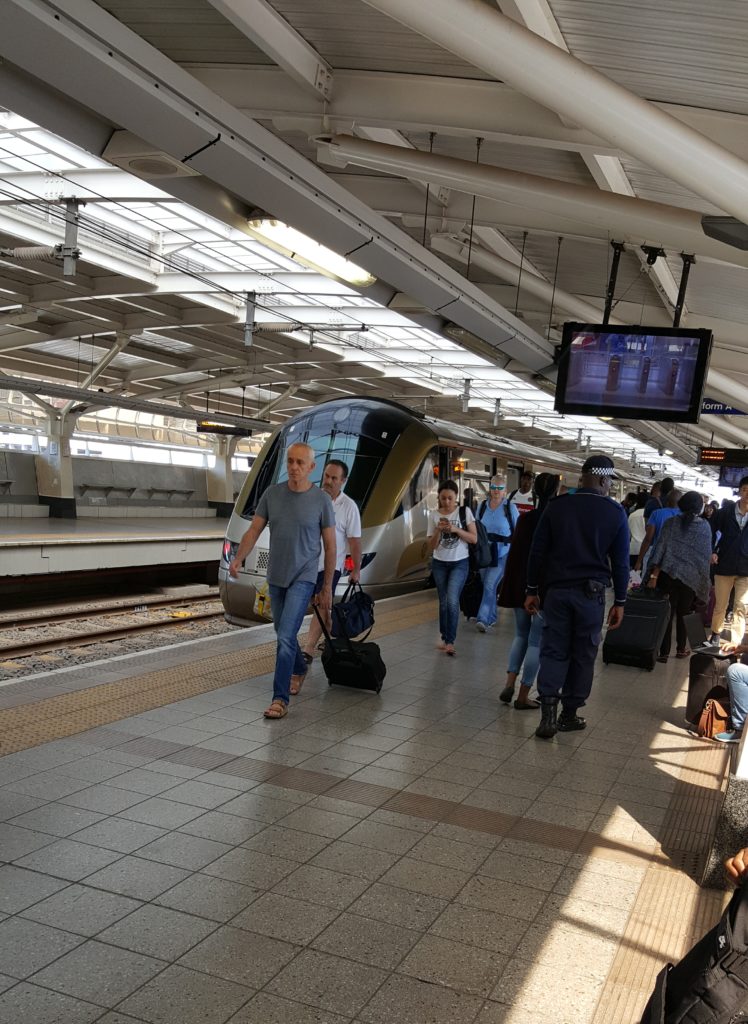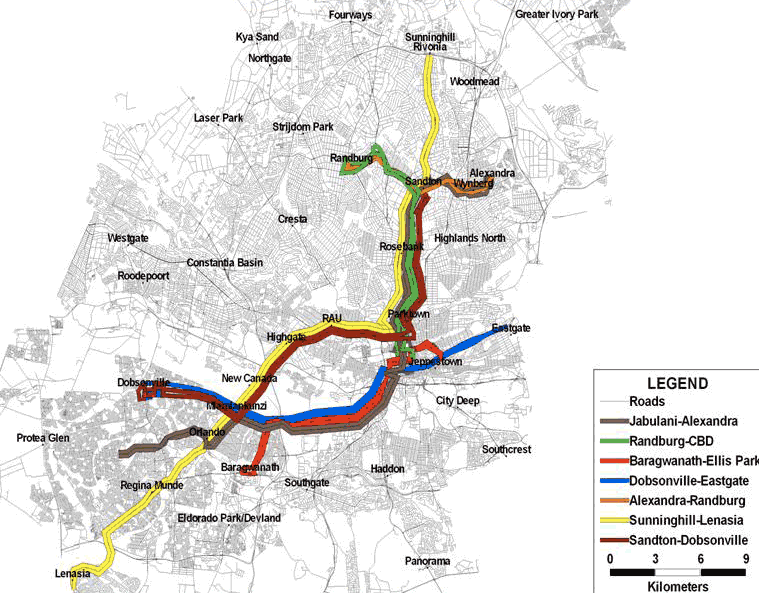 The Rea Vaya BRT. Photo Credit: Carlos Felipe Pardo
The Rea Vaya BRT. Photo Credit: Carlos Felipe Pardo
May 11, 2021
The Role of BRT in Post-Pandemic South Africa
This article originally appeared on Reorientations and is republished here with the permission of People-Oriented Cities
Public transport in South Africa is at a crossroad. Life is slowly returning to normal, with daily COVID-19 cases under 1,300. Ridership has returned to about 70% of the pre-COVID levels at least in some areas. National public transport policy, however, is in turmoil.
For a decade and a half, the National Department of Transport, and major cities like Cape Town and Johannesburg, embraced bus rapid transit (BRT) as a means of providing a high-quality rapid transit system quickly at a relatively low cost, while simultaneously transforming the minibus taxi industry into modern bus companies. Today, there is a growing push against the program, and increased subsidies into the rail sector, and no clear plan for how to support the massive minibus taxi industry. We analyze the current challenges and how the BRT system can be improved.
Public transport in South Africa before BRT
Because of its history of apartheid, many South Africans were forcibly relocated to distant townships, far from jobs which are clustered downtown in ports, industrial, and mining areas. During the apartheid era, the government subsidized city buses and trains to cover the costs associated with these distances. But as the government ran into financial crisis, these systems broke down, and increasing numbers of informal “minibus taxis” sprang up to serve the growing service gaps in these systems. These informal businesses were one of the few areas where the segregated South Africans could invest their savings. It became a huge industry that included not just the minibus taxi services, but also vehicle importers, repair shops, taxi associations, touts, fuel stations, and the banks that finance the taxi purchases.
The industry is not composed of companies, but rather, individual owners and drivers who are required to operate within associations. The routes are weakly regulated by the provincial and municipal authorities, allowing the associations to control the routes and protect their members from competition. Some of the vehicles are old and poorly maintained. Drivers work long hours to cover their rental costs, while owners are required to pay hefty fees to their associations, the banks who lend them the money, and the government. The business is volatile, insecure and sometimes violent for both the passengers and players within the industry.
Killings of rival taxi association leaders are all too common. Last year, in the Western Cape Province alone, there were 92 taxi industry-related murders. As the minibus taxis run from territory to territory, passengers are often forced to transfer to complete their journeys and pay again. The vehicles are often not insured, and road safety is a continuing issue as different drivers dangerously compete for passengers at the curb. Most often than not, influential leaders and decision makers in the government own these taxis, which makes them reluctant to impose any strict regulations in the industry. Naturally, the public is not thrilled with the quality of service, but often have no alternative. Minibus taxi ownership is also an entrepreneurial dead end for all but the taxi bosses.

BRT & the World Cup
By 2002, senior leadership had begun to embrace BRT as a way of bringing the minibus taxi industry into the formal sector as the owners of modern companies, with formal staff and better working conditions, stable salaries, and benefits. Having special stations and a dedicated right of way, it would be easier to regulate the companies allowed to use the BRT infrastructure.
With South Africa hosting the 2010 World Cup, BRT was the fastest, cheapest way to get a high-quality rapid transit connection between the townships, downtown, and the football stadiums, while leaving a lasting transit legacy. BRT had found its historical moment.
Operations for Johannesburg’s Rea Vaya BRT began in 2009, just three years after planning began, in time for the Confederations Cup. The system was state-of-the-art, safe, universally-accessible, beautifully designed, and its passengers were thrilled. It connected Soweto to downtown, as well as the main soccer stadiums at Ellis Park and NASREC. It also met a number of other important objectives including shorter travel times for passengers and cleaner buses. It also brought life back to the streets in downtown Johannesburg and improved security. There were all kinds of problems to work out, but it was an amazing and powerful symbol of equality that a high-quality BRT service could be built so quickly from Soweto to downtown.
Cape Town also built an impressive BRT — MyCiTi — very quickly, in about 4 years. Again, the standard of construction and quality-of-service were high, and the system was very much appreciated by its passengers.

In both cities, while the primary objective was to improve public transit for its current users, transitioning the minibus taxi industry into formal companies was key. This was partially achieved though it was not easy. The taxi industry was threatened by the project, as they weren’t, in fact, owners of buses. They threatened and attacked the bus owners and the local association leaders that supported the project. The Member of the Mayoral Committee for Transport in Johannesburg was attacked in her home and one of her security guards shot.
Despite the challenges, both Rea Vaya and MyCiTi were ultimately operated by new companies formed from the minibus taxi owners and associations that formerly operated on the BRT routes. These companies have varying degrees of governance problems, but minibus taxi owners were successfully transformed into formal companies.
BRT after the World Cup
After the World Cup, BRT construction slowed. To date, 88 km of BRT have been built in South Africa. This is a great achievement, unmatched by most countries. However, it is far less than 93 km that were meant to have been built in Johannesburg alone by 2010. Once the pressure of hosting the World Cup subsided, construction of subsequent phases lagged.
The last leg of the Johannesburg BRT, from Joburg CBD to Alexandra and Sandton, has been harder to complete as the road is quite narrow, the local taxi associations were not supportive, and excluded elements of the taxi and construction industries continually threaten construction contractors.
The second-tier cities have had more trouble. Their municipal administrations lack the resources of Johannesburg and Cape Town. Tshwane built a segment of its planned BRT, with low ridership, and expansion is delayed; eThekwini is on the cusp of finishing its first corridor, but negotiations with minibus taxi operators have stalled completion; Ekurhuleni (a municipality to the east of Johannesburg) just launched after a long delay, and Rustenberg is also stalled due to protracted negotiations with the taxi industry.
In 2017, then Minister for Transport, Joe Maswanganyi, said that the BRT system would probably be scaled down as it provided “no value at the end of the day.” This echoes the many articles written by advocates and academics in opposition to BRT. Since then, the South African National government, as well as the Western Cape and Gauteng Provincial governments have been turning their backs on BRT.
Certainly, ridership has been below expectations. Cape Town’s MyCiTi’s 70,000 daily pre-pandemic ridership is slightly lower than the projected roughly 100,000 estimated daily passengers. Rea Vaya is carrying about 56,000 daily passengers, fewer than an estimated 165,000 for this stage, though ridership was increasing. The reasons for this are discussed below.
The government is no longer willing to support BRT
While early promoters of the BRT system, ourselves included, said that under certain conditions (described in detail below), fare revenue can cover the operating costs, the assumptions under which this was achievable were never achieved. Pre-COVID cost recovery in Johannesburg’s Rea Vaya system was only around 30%. In Cape Town, cost recovery was up to about 50% but dropped to about 40% with the discontinuation of the N2 Express route.
With the very slow roll-out of the BRT program, only a small number of minibus taxi operators were formalized, leaving most of the industry in the same state as before, and taxi violence as bad as before.
In summary, BRT in South Africa, as it currently operates, has not met all of its goals. It successfully made travel faster, safer, and more comfortable for thousands of South Africans and formalized a piece of the minibus taxi industry. But it failed to deliver a subsidy-free rapid transit system in record time while simultaneously ridding the industry of organized crime and ensuring that no minibus taxi operator was made worse off.
While much is made of the weak cost recovery on the BRTs, per passenger BRT subsidies of R12.84 (.90 USD) in 2018 are lower than all other public transport subsidies besides minibus taxi. Municipal non-BRT buses were subsidized at R18.41 ($1.29) per passenger in 2018. Subsidies for rail operations far outstrip any other mode. Rail subsidies are directed at two very different services: the old commuter rail system dating from the apartheid era, and the modern Gautrain.

The Gautrain only moved about 50,000 daily passengers pre-COVID, though ridership had been growing. Each passenger trip is subsidized to the tune of over R100 (over $7 US). It consumes about 6% of the national budget, mostly in the form of a demand guarantee given to Gautrain’s PPP operator. During COVID, when ridership dropped to around 14% of its pre-COVID level, this demand guarantee hit the province particularly hard.
The old commuter rail system, Metrorail, consumes 51% of the national transportation budget, though it moves only about 9% of total daily public transport passengers. Despite consuming half of the transportation budget, ridership in the two biggest markets, Cape Town and Johannesburg, was halved between 2014 and 2018.
The loss of ridership on commuter rail is no mystery. Even before COVID, ridership has been in freefall due to mismanagement and corruption. Most famously, locomotives were procured that are unable to operate on South African tracks, exacerbating a severe shortage of rolling stock.
During COVID, 80% of the railway stations in the country were looted, stripped of cables, handrails, bricks, and doors. With no service running on parts of the Cape Town network, squatters have occupied the right of way, making the restoration of rail service a complicated proposition. And yet, the subsidies continue to flow.
Meanwhile, programs to directly support the minibus taxi industry have not been particularly successful. The main program targeted at the industry is the taxi recapitalization program managed by provincial governments with money from the National Department of Transport (NDOT). The program provides a fixed one-time subsidy to buy a new taxi under certain conditions. To qualify, a taxi operator needs a route license and to scrap their old vehicle. This program only received about 1% of NDOT funds, not because of an unwillingness to expand the program but because so few taxi operators were willing to participate. The issues with this program are well documented by Dr. Siyabulela Fobosi in his research.
Problems with the BRT program, explained
An often heard claim is that South Africa made a mistake following the “Bogotá model” because Johannesburg has much lower density, much longer trip times, and much more peaked demand than most Latin American systems. Ramon Muñoz-Raskin of the World Bank and Harvey Scorcia of CAF analyzed the BRT projects in South Africa and indeed blame these differences in demand patterns on lower-than-expected demand and higher-than-expected subsidies.
It is easy to blame a so-called “one-size fits all” solution on the problems of a system. However, these differences in South African land use and demand patterns were well understood from project inception. The projects were custom-designed to South African demand conditions by South African engineers and modelers, assisted by international advisors. The real problems, flagged as risks since the beginning in both Johannesburg and Cape Town, lie elsewhere.
- No competitive tender in BRT operator selection
In both Johannesburg and Cape Town, the municipalities followed the guidance in the National Land Transport Act (NLTA) on how to the incumbent industry could be incorporated and brought under new operating contracts. Given that many taxi owners held valid route licenses, Municipalities did not see a clear legal alternative to negotiating with the incumbent operators. This was fundamentally different than in Colombian cities where the BRT operating contracts were put out to competitive tender, but where bidders scored more points the more incumbent operators they had among their owners.Complicating matters, the National Government made a very public political commitment to ‘not make any incumbent minibus owner worse off.’ It is a benchmark that is almost unachievable in any process of change and has had a number of very serious consequences.
These two decisions undermined the municipalities’ leverage during the negotiation process. This drove the operating cost per kilometer about 40% higher than anticipated. The negotiation approach also undermined the ability of the municipalities to force better corporate governance on the companies, a transition goal which would have helped these companies in the long run to be competitive members of the formal sector.
Municipalities also lost control over project timelines, often resorting to expensive interim arrangements until contracts could be finalized. Competitive tendering in Bogotá and in other Colombian cities ensured that the agreement with the winning bidder would be completed on time.
In this regard, one of the most critical elements of the ‘Bogotá’ model wasn’t followed and yet, would likely have led to lower costs and stronger companies.
These contracts are coming up for review, giving South Africa a chance for renegotiation. This would ensure lower costs to the government and better service for the passengers. Ironically, South Africa’s Competition Commission is recommending just the opposite: renew the contracts without a tender, a central cause of the system’s deficits.

In both Johannesburg and Cape Town, there was no competitive tender in BRT operator selection -
Minibus taxis compete with BRT
The modeled ridership and financial outputs always assumed that the government would be able to regulate access to the market served by the BRT system. We always knew this was a risk and it was repeatedly identified as such. Despite many efforts to regulate the competing routes, in the end, many of the same operators that owned shares in the BRT companies also ended up operating routes directly competing with the BRT operations.Of course, the fact that minibus taxis are able to compete with the BRT by operating in mixed traffic on the same routes indicates, to some extent, a problem with the service plan of the BRT systems, as detailed below.
- Slowed construction after the World Cup
Without the urgency of the World Cup to roll out subsequent phases, network effects never took hold. The projects’ financial feasibilities, showing much lower subsidies than ultimately were required, were done for the full Phase 1 in Johannesburg, which was meant to be completed by 2010. It is still not complete, due largely, to a lack of political will.
The full Phase 1 BRT network for Johannesburg is still far from complete - Outmoded service plan
In the service planning respect, the critics are correct about the over-reliance on the ‘Bogotá’ model. At the time the service plan was developed, everyone was much enamored with trunk-feeder style service plans that had been first developed in Curitiba and later popularized in Bogotá’s TransMilenio. The Johannesburg service plan was not purely trunk-feeder. It included a few innovative new ‘complementary services’ that operated both on the trunk corridors and in mixed traffic, but the system was still primarily trunk-feeder.The great thing about a BRT service plan is that it can be easily modified. Today, we would recommend moving towards a more comprehensive direct services system to connect more destinations directly, bringing more minibus taxi owners into the system, provided they agree to corporatize.
- Operational and Enforcement Problems
The systems have also suffered from operational and enforcement problems. In both Cape Town and Johannesburg, the operational control systems have not worked well, leading to service irregularity. Enforcement of the dedicated bus lanes has been weak, causing delays. There were numerous problems with the introduction of the smart card systems which was long delayed, cost a lot for passengers and confused plenty of others. There were also numerous times when the systems were shut down for weeks at a time by strikes. As with the rail system, the BRT stations also fell victim to vandalism and people stealing wire and metal for scrap, leaving the stations dysfunctional in some way or another. All these issues have frustrated passengers. But none are particularly unique to South Africa, nor are they insurmountable.
The future of public transport spending in South Africa
Today, while National Department of Transport continues to support some ongoing BRT projects, funding for many of the BRT projects has stopped completely, and the department is under political pressure to water down the program. Of course, running buses in mixed traffic or blocked curbside bus lanes will not magically reduce the need for operating subsidies. Meanwhile, calls to subsidize the minibus taxi industry are growing.
The idea of using government money to encourage more transparent governance and faster company formation within the taxi industry is a good one, especially given that the industry will continue to carry the largest share of public transport passengers well into the future. Improved municipal regulation of the industry is critical, including, for example, greater municipal involvement in taxi ranks.
It is not clear, however, that this is the plan. The Western Cape has mooted the idea of a ‘Blue Dot’ program, offering a flat subsidy per taxi license in the belief that this would buy them regulatory leverage to reduce the violence. However, taxis don’t operate scheduled services, and specific passenger numbers per route and per local association are hard to verify. The monthly subsidy cash into the sector could worsen the often chronic and sometimes violent rivalry. In order for the industry to receive subsidies, it would need formal accounting systems. But the informal nature of the industry makes establishment of such a system impossible.
National DOT has floated a reasonable suggestion to competitively award funding to municipalities able to develop plans consistent with broad national objectives. This would give those municipalities supportive of BRT the latitude to continue their programs, while also allowing municipalities the freedom to experiment with other approaches.
The Competition Commission recommends continuing rail subsidies while devolving control to yet-to-be-created provincial-level public transport authorities. These proposed authorities would take control of all National DOT funding. This suggestion threatens the authority of cities, which are the only unit of government currently successful at managing public transport. Cities are also the only level of government with a hope of coordinating transport spending with land use policy. This is perhaps the most critical issue for overcoming the spatial legacy of apartheid and boosting ridership on the BRTs.
In general, National DOT should be clear about its priorities. Continuing to subsidize rail and municipal bus operations but scaling back from real BRT — which carries lower subsidies than both — signals that there may be other reasons for moving away from BRT. The success of the program has been mixed but the problems are fixable. Rather than move away from BRT, South Africa should bring more routes onto the BRT infrastructure it has, fix the operational and contractual problems, and expand the systems where justified.
The Rea vaya BRT. Photo credit: Carlos Felipe Pardo
Minibus Taxi. Photo Credit: AfricanGoals2010
Gautrain: Photo Credit: HelenSTB
MyCiti BRT. Photo Credit: MyCiti BRT Adderley station
